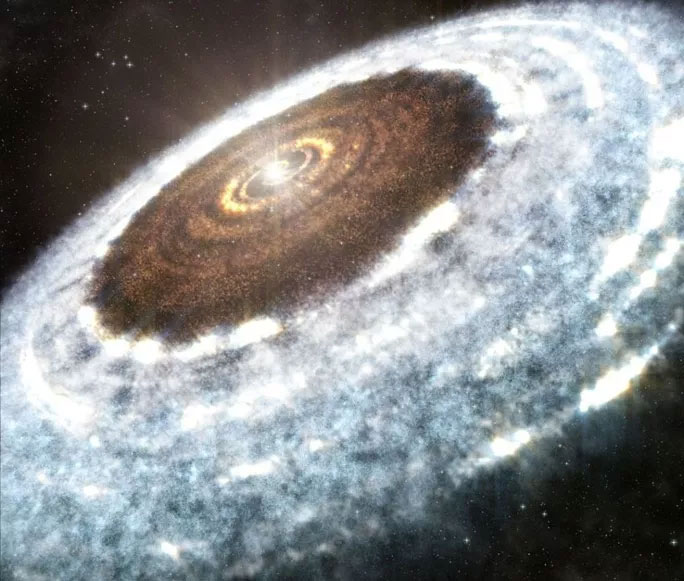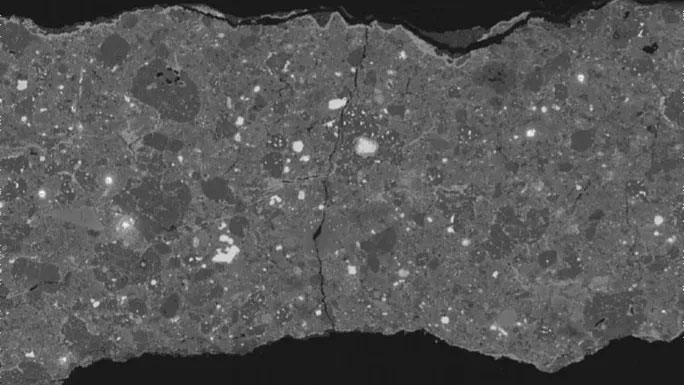An ancient object than the Earth fell into the Sahara, revealing the secret of 'earthquake'
Our oldest homeland may be a snow circle - the beautiful water around the young sun, which provides materials to shape the Earth and its neighbors.
Research led by Earth and planetary scientist Meguma Matsumoto (Kyoto University, Japan) has found a strange thing called "ice fossils" in a meteorite dating back 4.6 billion years. age five, equivalent to the age of the Solar System and "older" than the earth.

The beautiful image of snow and water around the young star V883 Orionis is the image of the Solar System 4.6 billion years ago - (photo: ESO / NAOJ / NRAO).
The asteroid, named Acfer 094m, fell to Algeria in the Sahara Desert (North Africa) in 1990. Modern analytical tools have helped scientists identify it as a "primitive meteorite". " , the rare and precious remnant of the solar nebula.
The "ice fossils" inside this ancient meteorite shed light on how asteroids formed in the early solar system, then to the asteroids. In other words, the fossil consists of fine silicate dust containing silicate, sulfur and this organic material that represents one of the "planet building blocks" that make up Earth and all other planets. in the Solar System.

Close-up of ancient meteorite bearing "ice fossils" - (photo: Natural History Museum).
According to Matsumoto, the fossil material has a strange structure consisting of a smooth mass of silicate and other materials surrounded by an icy layer of pure water.
It has revealed our home image of our early Solar System. At that time, there was no Earth and other planets. Only a young sun is shining amidst a beautiful icy stream, "flowing" in a closed loop around it. This image has been observed in several other young stars in the universe - the very beginning of the other "Solar System" .
In that past Solar System, swirling dust, gas and even ice condensed, forming rock asteroids or lunar-sized objects, and then planets.
During formation, new objects tend to head towards the sun, causing the ancient ice to belong to the snow ring - the old water began to melt, turning into fossils of ice. Accidentally, ice fossils have "crept" into the cracks of this ancient meteorite, preserved and followed a mysterious path, landed on Earth after billions of years of wandering.
The research has just been published in the scientific journal Science Advances.
- The object fell to Earth, destroying saber-tooth tigers 13,000 years ago
- Little known facts about the Sahara desert
- The secret of awe of an ancient Mexican group
- The arid Sahara desert used to be the place where the largest marine creatures lived
- Snow fell for the first time in 37 years in the Sahara
- Found rare sahara newspaper
- Revealing the mysteries of the Earth makes everyone 'startled'
- Found the true age of the Sahara desert?
- The wild world on the Sahara desert
- The secret of living ants is free in the Sahara desert
- Could it be that humans have turned the Sahara into a desert?
- Hanoi Building shook because of the continuous earthquake in Son La
 Van Allen's belt and evidence that the Apollo 11 mission to the Moon was myth
Van Allen's belt and evidence that the Apollo 11 mission to the Moon was myth The levels of civilization in the universe (Kardashev scale)
The levels of civilization in the universe (Kardashev scale) Today Mars, the sun and the Earth are aligned
Today Mars, the sun and the Earth are aligned The Amazon owner announced a secret plan to build a space base for thousands of people
The Amazon owner announced a secret plan to build a space base for thousands of people